GrAY BEARD
Beard colour - an alternative?

Sooner or later, the inevitable happens: as we all know, time catches up with men, and grey hairs are gaining ground. If they don't come too early, a splash of grey can be charming and even attractive (just look at Richard Gere and George Clooney). However, a grey or white beard can in some cases add years to your appearance, at least if you belong to the younger age group and if the grey strands invade too large an area. However, there are remedies for this - they won't make time go backwards, but can temporarily make your real age more accurate and push the 'problem' ahead of you.
If you've started to get some grey hairs in a few places in your beard, you can try a different beard style to avoid hair growth in those areas. If you have a grey beard on your chin, you can go for a moustache instead. It goes without saying, however, that you are only buying time here, because soon the grey hairs will spread to other parts of the beard as well and there are limits to how much you can eventually shave off.
If you have a few splashes of grey in your hair, it may be a good idea to leave a few splashes of grey in your beard to create a more natural look.
The absolute best solution (especially if you still have dark hair on your head or have coloured it) is to dye your beard. It's not as kinky as it sounds, these days there are actually quite effective remedies and imaginative gadgets available and it's an area that is increasingly attracting commercial interest. Manufacturers like Active Men have beard colours in several shades.
THE MOST IMPORTANT THING TO KEEP IN MIND WHEN IT COMES TO BEARD COLOUR IS THIS:
- Choose a colour that is as close to your natural shade as possible (or that harmonises with the one in your head hair), otherwise it can look odd.
- Apply plenty of colour to the areas you want to emphasise with your beard, preferably along the chin line and on the underside. The most important thing for a varied result is not to apply equal amounts of colour everywhere, as this can make your beard look tacky. It may take some practice and creativity to get it looking perfect, but it will come together quickly. Also, feel free to use a comb to draw out the colour in some areas (such as the cheeks) instead of a brush to give it a thinner striped look. If you have some grey splashes in your hair, it may be a good idea to leave a few grey splashes in your beard to create a more natural look.
- To avoid getting paint on the skin outside the beard line, apply a greasy cream (such as Vaseline) to the areas where you don't want the paint to end up in case it runs out.
- If in doubt between two colours, always choose the lighter one just in case. Too dark can lead to a harsh and unnatural result.
However, beard colours can be strong stuff, so if you know you have sensitive skin and can react with nasty eczema, eyebrow dye may be an option; although it contains 3% hydrogen peroxide, it seems to be slightly more gentle and doesn't stick to the skin as much.
You can control how pronounced you want your beard to be in different areas - a normal beard is rarely completely uniform across the face.
One tip is that the hair shampoo from Active Men, which is specially designed for coloured hair, also works perfectly for the lengths of coloured beards! The shampoo is enriched with sunflower extract that adds moisture and leaves the beard soft with a healthy glow, while preserving the colour for an extra long time.
A new category of beard dyes are the exciting powder versions - known as beardfillers - where you can temporarily add a touch of colour to the grey areas. They are massaged into the beard or moustache with a small brush and are also suitable for filling in sparse patches in your beard and enhancing lines. One of the benefits of fillers is that you can easily control how pronounced you want your beard to be in different areas - a normal beard is rarely completely uniform across the face. This way you can achieve a vibrant and natural look. The disadvantage is that it goes away when you wash your face and can be touched up afterwards, but some people see this as an advantage in itself. As usual, it's all about what you prioritise.
Tips!
Okay, let's say you're clean-shaven and want to start growing a beard, but it turns out the beard you're growing is white or grey, and you may have dyed your head hair or your hair colour is naturally darker than your beard. For some, this isn't much of a problem, but for others, white stubble against dark hair doesn't feel like something to aspire to unless you're modelled on Carl-Anton in the White Mountains. And traditional beard dye will only lay on the skin (or not at all) if the stubble is too short, so dyeing it as usual won't work. Here, the aforementioned beard filler (such as Benjamin Barber's) is a good solution that can save your incipient beard growth from being shaved off. The filler adheres well to a short stubble and gives a softer impression than colour. If nothing else, you can get a nice five o'clock shadow this way while your facial hair is growing. When the beard starts to pass the stubble stage and grow in, you can always bring out the beard colour.
One thing is certain: for the curious and inquisitive, there is a plethora of interesting products today and new exciting variants are constantly emerging. Some of the newest are wide "marker pen"-like application pencils with non-permanent but still relatively durable beard colour (good even in the hair!) and pencil-like colour pencils with a fine tip to mark fine lines and details. Just give it a try!






